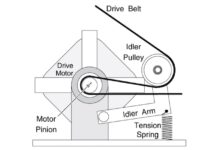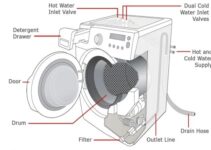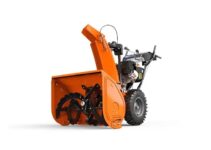Samsung top loader washing machines are popular among many households due to their efficient cleaning capabilities and durability. However, like any appliance, they may experience issues that require attention and fixing.
Knowing the parts of the washer would help with maintenance and ensure that you use the washer properly.
Samsung Top Loader Washer Parts Diagram

Samsung Top Loader Washer Parts Details
Inlet Hose
The inlet hose is a rubber hose that carries water from your home’s plumbing system into the washing machine. It is typically located on the back of the washing machine and is connected to the water supply valves.
The inlet hose is an important part of the washing machine, as it ensures that the machine has a steady supply of water for washing clothes.
Spin Lid
The Spin lid is a feature that allows users to easily and safely open and close the washer lid during the wash cycle. It helps to prevent spills and splashes and allows for easy access to the wash drum. The lid also has a safety lock to prevent it from accidentally opening during the wash cycle.
Spin Tub
The Spin Tub is a feature that helps improve the washing performance of the machine. It uses a high-speed spin to remove excess water from clothes during the wash cycle, allowing for faster drying times and more efficient use of energy. The Spin Tub is typically found on higher-end models of Samsung top load washers.
Magic Filter
The Magic Filter is a lint and debris filter that is located inside the washer drum. It captures and traps small particles that can accumulate during the wash cycle, helping to keep the washer and clothes clean and free of lint and debris. The Magic Filter can be easily accessed and cleaned to maintain the washer’s performance and efficiency.
Power Cord
The power cord is a flexible cable that connects the washer to an electrical outlet, providing power to the appliance. It typically has three prongs – one for the neutral wire, one for the hot wire, and one for the ground wire – and is often labeled with the voltage and amperage rating.
Wash Lid
The wash lid is the hinged lid that covers the opening of the wash tub. It is typically made of plastic or metal and is used to keep water and laundry items inside the tub during the wash cycle. The wash lid may also have a locking mechanism to prevent accidental opening during the wash cycle.
Pulsator
The Pulsator is a feature that helps to create powerful water currents within the wash tub, ensuring that the clothes are thoroughly cleaned and rinsed. The pulsating motion helps to remove dirt and stains from the fabrics, and can be customized according to the type and amount of laundry being washed.
Drain Hose
The drain hose is a flexible tube that connects the washer to the drainage system in the home. It carries the wastewater from the washer to the designated drainage area, typically a plumbing pipe or a utility sink. The drain hose is usually located at the back of the washer and can be detached for cleaning or replacement.
Twin Tub
The Twin Tub is a feature that allows for two separate wash and spin tubs. This allows for a more efficient and flexible wash cycle, as different types of clothes can be washed and spun separately in the same cycle. The Twin Tub also allows for a faster wash and spin cycle, as the clothes can be washed and spun simultaneously in the two separate tubs.
Plastic Filter
The plastic filter is a small component located at the bottom of the washing machine that is used to catch and trap lint, hair, and other small debris during the wash cycle.
This filter helps to prevent clogging of the washing machine’s drain system and ensures that the water flows freely during the wash cycle. The plastic filter should be cleaned regularly to maintain the efficiency and performance of the washing machine.
Wash/Spin Inlet Selector
The Wash/Spin Inlet Selector on a Samsung top load washer is a dial or knob that allows the user to select the appropriate water inlet for the wash and spin cycles. This allows the user to control which water source is used for the washing and rinsing of clothes, as well as the spin cycle.
This can be useful for those who have multiple water sources, such as a hot and cold water line, or for those who want to use a specific water source for different wash and spin cycles.
Common Samsung Top Loader Washer Problems and their Fixes
Washer not draining properly: This issue can be caused by a clogged drain hose or a faulty drain pump. To fix this, first check the drain hose for any clogs and remove them if necessary. If the issue persists, try replacing the drain pump with a new one.
Washer not spinning: This issue may be caused by a faulty lid switch or a broken belt. To fix this, first check if the lid switch is working properly and replace it if necessary. If the issue persists, check the belt for any signs of wear and tear and replace it if needed.
Washer not filling with water: This issue may be caused by a faulty water inlet valve or a clogged water filter. To fix this, first check the water inlet valve for any signs of damage and replace it if necessary. If the issue persists, check the water filter for any clogs and clean or replace it if needed.
Washer not agitating: This issue may be caused by a faulty drive motor or a broken agitator. To fix this, first check the drive motor for any signs of damage and replace it if necessary. If the issue persists, check the agitator for any signs of damage and replace it if needed.
Washer making strange noises: This issue may be caused by a faulty bearing or a broken suspension spring. To fix this, first check the bearing for any signs of damage and replace it if necessary. If the issue persists, check the suspension spring for any signs of damage and replace it if needed.





